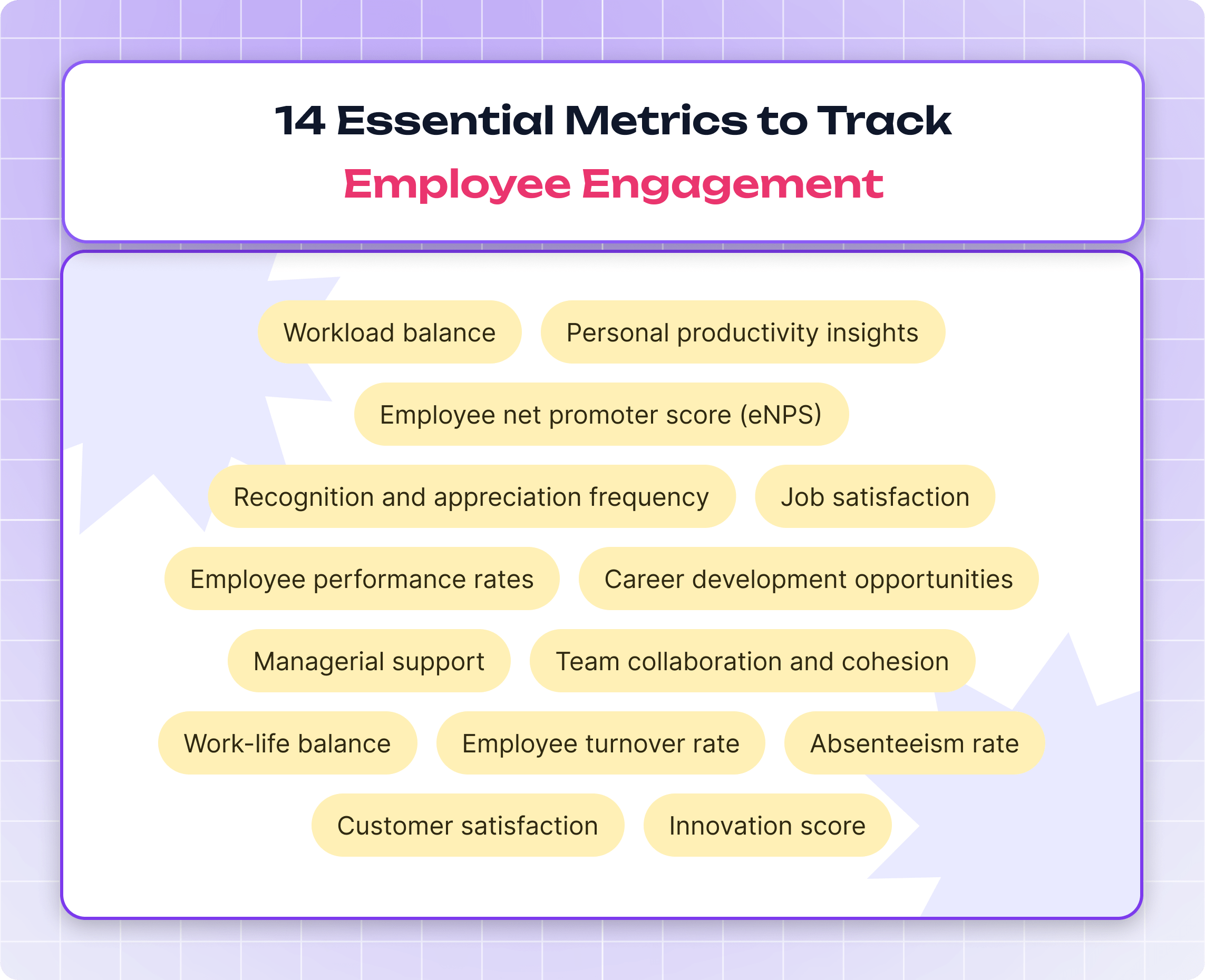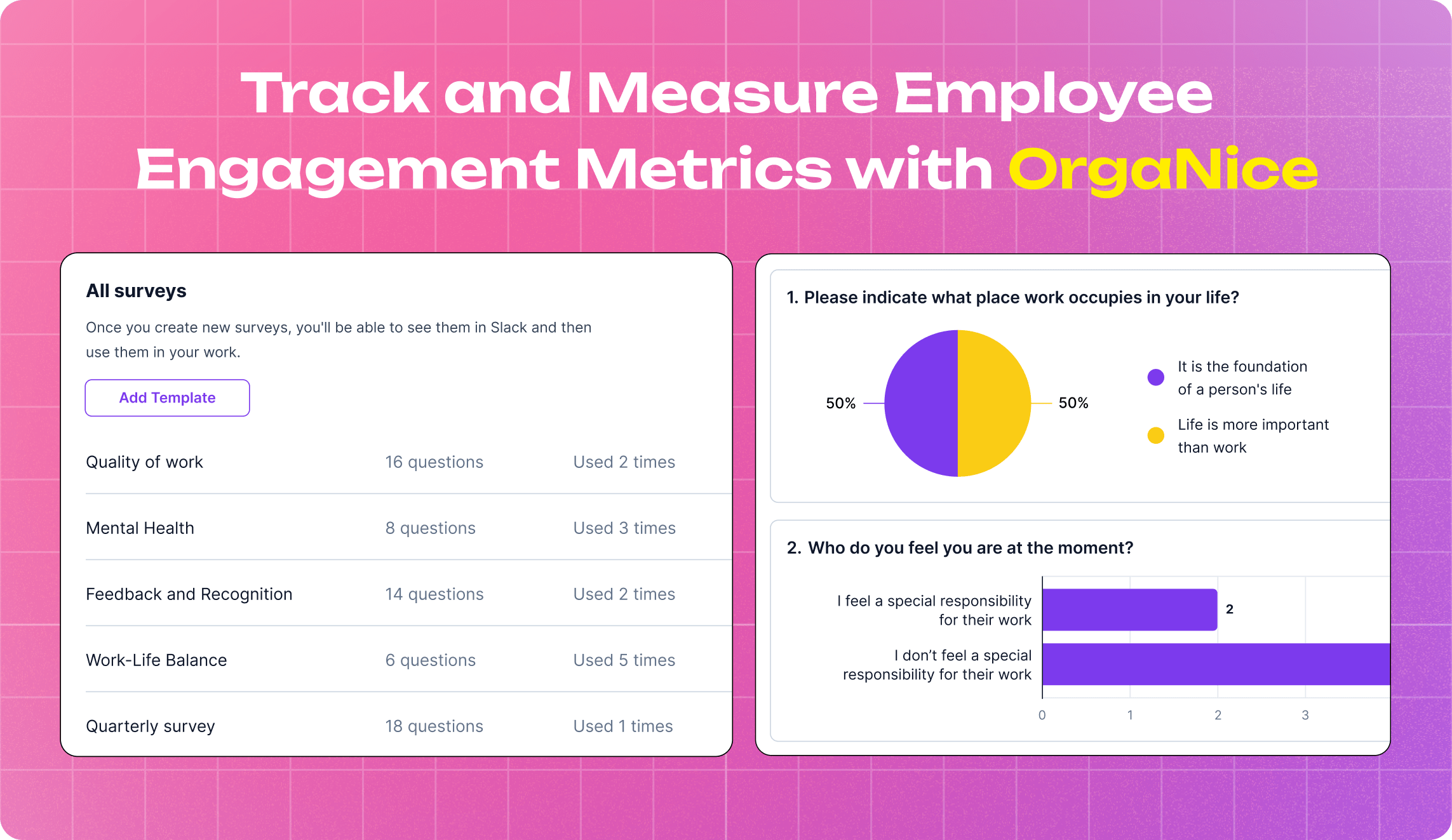
When your employees thrive, your business follows suit, and when they disengage, everything from productivity to profitability takes a hit. The most successful companies know that engaged employees are more productive, more loyal, and more likely to go the extra mile. But engagement isn’t just about gut feeling or casual observation. It’s about data and that’s where metrics for employee engagement come in.
Think of these metrics as the heartbeat of your workplace culture. They reveal how your team feels, how connected they are to the company’s mission, and where improvements are needed. Without them, leaders are essentially steering in the dark, guessing what’s working and what’s not. With them, you can make evidence-based decisions that actually move the needle.
In this article, we’ll break down the 14 most important engagement KPIs, show you how to measure employee engagement metrics, and explain how to turn raw data into meaningful action.
What Do Employee Engagement Surveys Measure
Employee engagement surveys measure the emotional, cognitive, and behavioral connection employees have to their work and organization. They assess areas such as job satisfaction, trust in leadership, recognition, workload balance, and opportunities for professional growth. These surveys also capture perceptions of teamwork, inclusivity, and the overall work environment.
Why Measuring Employee Engagement Metrics Is Important
Monitoring and tracking employee engagement metrics gives organizations the power to act early and stay ahead of potential challenges. When you can spot signs of disengagement before they snowball, you protect productivity, reduce turnover, and keep your teams aligned with your company’s mission and goals. Some of the biggest advantages of measuring these metrics include:
- early problem detection (spot drops in engagement before they impact productivity or turnover);
- objective assessment (replace guesswork with concrete, data-driven insights);
- track changes over time (monitor how engagement evolves following initiatives or organizational shifts);
- prioritize actions (identify the most critical areas needing improvement and allocate resources wisely);
- support strategic decisions (provide leadership with evidence to refine policies, culture, and processes);
- compare teams and departments (uncover disparities in engagement levels across the organization);
- foundation for continuous improvement (establish a baseline to measure the effectiveness of engagement programs).
Research shows just how powerful these metrics are. Gallup reports that companies with highly engaged employees experience 21% higher profitability, 41% lower absenteeism, and 59% less turnover. Meanwhile, Deloitte found that organizations with strong employee engagement strategies are twice as likely to outperform their competitors.
14 Vital Metrics to Measure Employee Engagement
What are the most effective metrics for measuring employee engagement? Let’s take a closer look at 14 important examples of employee engagement metrics that can help you accurately assess and improve workplace motivation and satisfaction.

1. Workload Balance
This metric assesses how fairly and realistically tasks and responsibilities are distributed among employees. It measures whether individuals feel their workload is manageable within the time and resources they have. Overloading leads to stress and burnout, while too little work can cause boredom and disengagement, making workload balance essential for well-being and engagement.
By tracking this metric, organizations can identify teams or individuals at risk of overload or underutilization and take action to redistribute tasks, adjust deadlines, or provide additional support.
2. Personal Productivity Insights
How effectively employees manage their time, prioritize tasks, and complete their work plays a crucial role in overall engagement. These insights highlight individual strengths and challenges in handling daily responsibilities, revealing obstacles like distractions, unclear goals, or inefficient processes.
Understanding personal productivity allows managers to offer targeted support such as time management training, better tools, or clearer workflows. Improving this metric not only boosts individual performance but also contributes to overall team effectiveness and engagement.
3. Employee Net Promoter Score (eNPS)
The eNPS measures how likely employees are to recommend their workplace to friends or colleagues, making it a key indicator of engagement and overall satisfaction. This metric is typically gathered by asking a simple question: “On a scale from 0 to 10, how likely are you to recommend working here?”
Responses are grouped into three categories:
- detractors (0-6);
- passives (7-8);
- promoters (9-10).
To calculate eNPS, use this formula:
Employee NPS = (Number of Promoters – Number of Detractors) / Total Respondents
4. Recognition and Appreciation Frequency
This metric tracks how often employees receive acknowledgment for their efforts and achievements. Regular recognition fosters a culture of appreciation, making employees feel valued and motivated to maintain high performance.
According to a recent Gallup report, employees who receive recognition at least once a week are 2.9 times more likely to agree that they receive valuable feedback from their colleagues.
5. Job Satisfaction
Employee contentment is one of the most crucial employee engagement metrics that reflects how content employees are with their roles, responsibilities, and working conditions. It encompasses factors like task variety, autonomy, and the meaningfulness of work.
High role satisfaction correlates strongly with engagement, as satisfied employees are more motivated and loyal. One practical approach is to use employee surveys with Likert-scale questions (e.g., rating satisfaction from 1 to 5) and calculate an average satisfaction score.
6. Employee Performance Rates
Engaged employees consistently deliver strong results, driven by their commitment to the company’s goals and their roles. Evaluating employee performance alongside engagement metrics offers a clearer picture of how satisfied and motivated individuals are in their positions.
Employee performance can generally be broken down into four key areas:
- quality of work (measures accuracy, attention to detail, and the standard of completed tasks);
- quantity of work (tracks the volume or output produced within a given timeframe);
- efficiency (assesses how well employees use their time and resources to complete tasks);
- contribution to organizational goals (evaluates how individual efforts align with and impact overall company performance).
7. Career Development Opportunities
Career development metrics evaluate employees’ perceptions of growth and advancement possibilities within the organization. Access to training, mentorship, and clear promotion paths are key components.
Employees who see opportunities to develop skills and advance tend to be more engaged and less likely to leave. Tracking this metric allows companies to improve professional development programs and retain top talent.
8. Managerial Support
This metric reflects the extent to which employees feel backed by their immediate supervisors through consistent feedback, availability, and encouragement. It considers not only how often managers communicate but also the quality and effectiveness of their support.
Strong managerial support fosters trust and psychological safety, which are essential for creativity, risk-taking, and sustained engagement. When employees feel genuinely supported, they’re more likely to take initiative, stay motivated, and contribute fully to organizational goals.
9. Team Collaboration and Cohesion
The quality of employee interactions and mutual support is a crucial part of the key employee engagement metrics. This metric evaluates how effectively team members work together, share information, and support one another.
High team cohesion fosters a positive work environment that enhances collective motivation and drives success, whereas poor collaboration can isolate individuals and reduce motivation.
10. Work-Life Balance
Managing career and personal life demands is essential for employee well-being and sustained engagement. This metric assesses how well employees are able to balance their professional responsibilities with their personal time and commitments.
When employees maintain a healthy work-life balance, they report lower stress levels and higher job satisfaction, which directly contributes to increased productivity and loyalty. On the other hand, poor balance can lead to burnout, absenteeism, and higher turnover rates.
11. Employee Turnover Rate
When it comes to other common employee engagement metrics, turnover rate plays a key role. This metric tracks how frequently employees leave the organization within a given period. High turnover often signals low engagement, dissatisfaction, or poor cultural fit.
To calculate turnover rate, divide the number of employees who exited during the period by the total number of employees at the beginning, then multiply by 100 to express it as a percentage.
12. Absenteeism Rate
Keeping track of employee absenteeism is key to understanding how often workers miss days without approval, which is often a sign of deeper engagement or satisfaction problems. When this metric rises, the extra workload shifts to other team members, increasing their stress and lowering overall morale.
The absenteeism rate is calculated by taking the total number of absent days across employees, dividing it by the total number of working days available, and multiplying by 100 to get a percentage.
13. Customer Satisfaction
Think of customer satisfaction as a mirror reflecting how well your employees are doing on the front lines. When your team is truly passionate, focused, and motivated, they naturally deliver better experiences to customers. Happy customers mean repeat business, positive reviews, and a stronger reputation.
Measuring customer satisfaction isn’t just about numbers; it tells a story about your people and their connection to the company. By asking customers for their honest feedback through anonymous surveys or ratings, you get real insights into how your employees’ engagement translates into everyday success.
14. Innovation Score
How employees perceive their company’s openness to creativity and new ideas speaks volumes about the workplace culture. It’s about feeling empowered to experiment, share suggestions, and take calculated risks without hesitation. When innovation is truly valued, employees become more engaged, and eager to drive positive change.
To calculate this score, organizations typically use surveys asking employees to rate statements related to innovation openness, such as “My company encourages new ideas” or “I feel safe to take risks at work” on a scale (e.g., 1 to 5).










